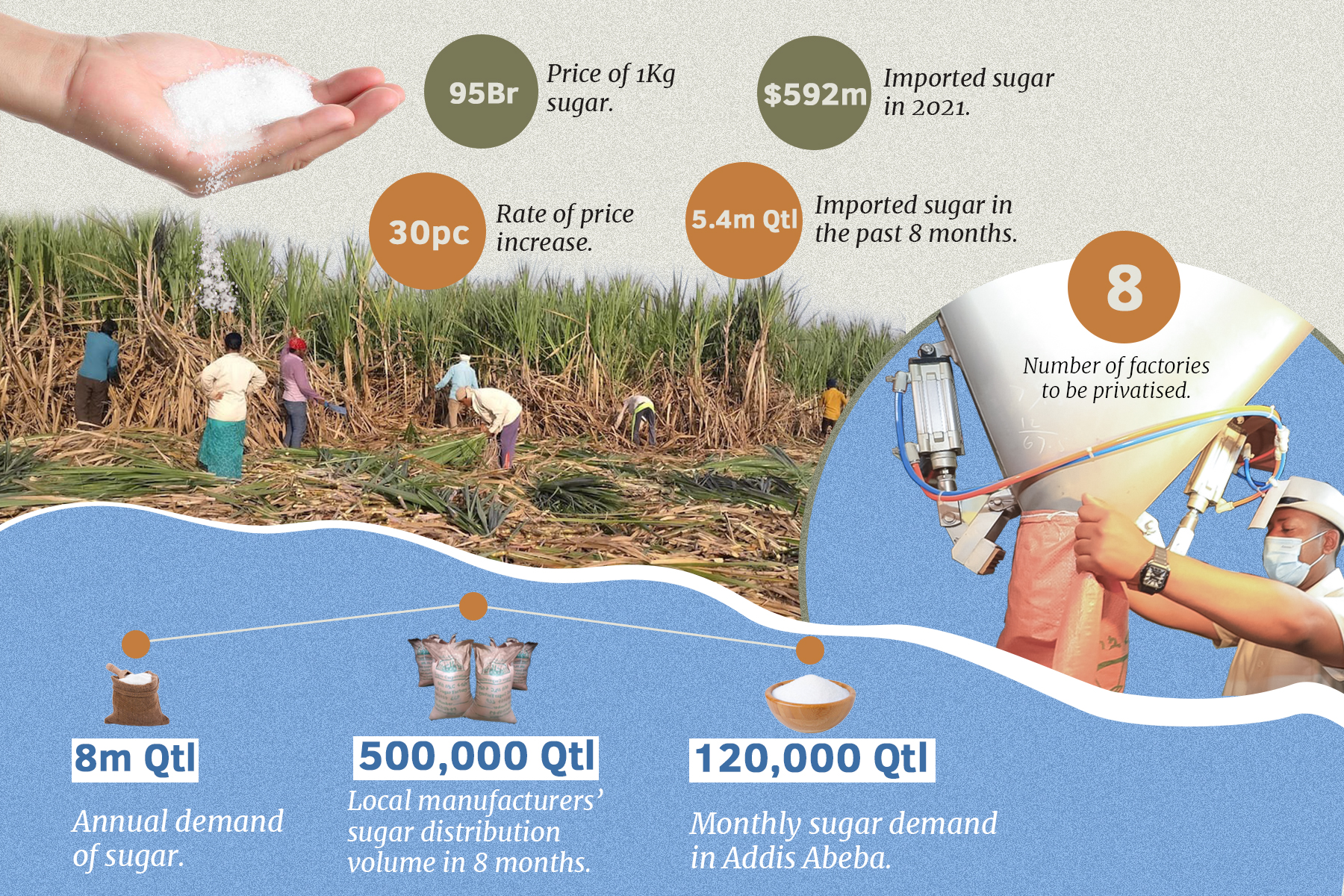
Radar | Aug 10,2019
Feb 22 , 2020
By Abdeta D. Beyene
The Addis Abeba-Djibouti economic corridor affords Ethiopia and Djibouti an opportunity to realise their economic ambitions. To succeed, the countries must have a long-term plan in mind, writes Abdeta D. Beyene (PhD) (beyeneabdeta@gmail.com), executive director at Centre for Dialogue, Research & Cooperation.
Ethiopia and Djibouti have realised a strategic partnership in their bilateral relations manifested in the political, economic, cultural, peace and security cooperation spheres. Due to the countries’ robust bilateral cooperation, the two governments have designed a strategic cooperative framework to effectively foster sustainable development, enhance trade competitiveness and achieve regional integration in the Horn of Africa. Both have also decided to undertake diversified mega projects in parallel and with joint ownership along the Addis Abeba-Djibouti economic corridor.
Major development projects undertaken in recent years along this corridor include transportation infrastructure, industrial park developments, dry ports and multi-purpose port expansions in Djibouti, as well as power transmission and telecommunication links between the two countries.
In 2016, Ethiopia and Djibouti replaced the old diesel railway system, which ceased operating in 2011, with the construction of a jointly owned 752Km standard-gauge electrified railway project with a total investment of 4.3 billion dollars that became operational on January 1, 2018.
Nine of the industrial parks, out of over a dozen, are positioned along the Addis Abeba-Djibouti railway line, according to the Industrial Parks Development Corporation. They are designed to specialise in manufacturing textiles and garments with great potential for export diversification. Ethiopia has already developed the Bole Lemi I and II, Qilinto, Dukem, Adama and Dire Dawa industrial parks along the Addis Abeba-Djibouti economic corridor. The industrial parks in Bole Lemi, Qilinto and Adama have been fully developed with government resources.
Ethiopia has also established inland dry ports across the country. The Modjo Dry Port was the first dry port along the Addis Abeba-Djibouti corridor. It increased its capacity in 2012 to handle the multi-modal transport system. Other ongoing dry port developments along the corridor include the full-scale dry ports in Semera, Dire Dawa and Kombolcha.
Electric power, optic fiber and microwave telecommunications are other sectors of cooperation. Ethiopia’s first electric power connection to a neighboring country was completed in 2011 with the 230Kv interconnection transmission lines between Dire Dawa and Jaba in Djibouti, which secures Ethiopia dozens of millions of dollars every year. Besides this, through Djibouti Ethiopia is interconnected to submarine cables and microwave networks, which has had a direct corresponding effect on broadband uptake in the country.
There have been major port expansion projects underway in Djibouti for the last ten years with the goal of becoming the heart of shipping on the continent through foreign investment, mainly from Chinese companies.
In 2018, Djibouti inaugurated the first phase of the Djibouti International Free Trade Zone (DIFTZ), the largest in Africa, at a total project cost of 3.5 billion dollars. The DIFTZ is a joint venture between China Merchants Group and the Djibouti government. In addition, a new terminal - Doraleh Multipurpose Port (DMP) - was inaugurated in 2017 in a joint venture between the Djibouti government and China Merchants Group. Besides this, the Doraleh Container Terminal (DCT) has been transferred to CMPort with the government retaining a minority share and an oil terminal that handles petroleum products, has been redeveloped to facilitate loading for the new railway oil freight service.
Ethiopia and Djibouti have both received substantive loans and investments from China in recent decades. Ethiopia is the third-largest recipient of external financing for the infrastructure sector in sub-Saharan Africa, and China’s impact has been quite significant. In fact, Ethiopia’s diversified transport projects and industrial park development are key manifestations of China’s Africa policy.
The Addis-Djibouti railway connecting Ethiopia to the maritime trade routes of the Gulf of Aden and the Red Sea are two examples of the multitude of Chinese cooperative frameworks and investments in the Horn of Africa. And China’s first overseas naval logistical base established in strategic deep water at the port of Djibouti is also linked to this.
Moreover, the Belt & Road Initiative (BRI) launched in 2013 is China’s signature vision and forges intertwining economic, political and security ties between China and the entire world, Africa included. The BRI is increasingly seen as a catalyst for African regional economic integration and competitiveness.
In 2018, China pledged to extend 60 billion dollars of new funding to Africa aimed at supporting inclusive development, and the country is now providing mechanisms for debt rescheduling and possible cancellations. As the early focus of the Belt & Road Initiative, East Africa has developed into a central node in the Maritime Silk Road, connected by planned and finished ports, pipelines, railways and power plants that Chinese companies have built through bilateral financial arrangements.
The Addis Abeba-Djibouti economic corridor development programme is a key long-term strategic cooperation framework that both countries’ governments have designed and implemented. The economies of both countries are so interdependent that any challenge that one faces is immediately replicated in the other, and in terms of development as well. The economic potential of the Addis Abeba-Djibouti economic corridor is thus immense.
One of the benefits of this is trade facilitation. The Addis Abeba-Djibouti corridor linking Ethiopia to the Port of Djibouti is currently the dominant gateway for the country, managing over 95pc of Ethiopia’s imports and exports. Undoubtedly, the Addis Abeba-Djibouti railway has the potential to significantly reduce transport costs and time. A journey that used to take traders three days has been reduced to less than one day; the cost of transporting cargo is 0.051 dollars a tonne for a kilometre. The current operation of the new railway system is expected to transport 40pc of what trucks have been transporting; a single railway freight transport has about the same capacity as 100 trucks.
The benefits also lie in export competitiveness. There is a common understanding that Ethiopia’s export sector remains particularly small. Total goods and services exports do not exceed 10pc of GDP, significantly below the 24pc expected from a country the size of Ethiopia at its level of development. However, there is enormous potential for export growth, from both adding value to existing exports and greater diversification.
The role played by the economic corridor to help Ethiopia attract foreign direct investment (FDI) is also nothing to baulk at. In recent years, the attention of many multinational companies has focused on Ethiopia, and they have rapidly boosted their investment. Ethiopia was the second largest FDI recipient in Africa, according to a report by UNCTAD and the World Bank in 2017, although recent performance has not been as promising. This is mainly due to the government’s heavy engagement in expanding the development of more new industrial parks across the country. The government’s initiative, offering serviced industrial land, pre-built sheds equipped with utilities and infrastructural facilities that fit international standards have created great potential to secure the interest of more multinational companies thinking to move to Ethiopia.
The Addis Abeba-Djibouti economic corridor, by way of the standard-gauge electrified railway, also represents a green high-capacity transport mode that is fast and convenient, land-saving, energy-saving, environmentally friendly and safe. Similarly, for industrial park development, the government of Ethiopia has invested in a state-of-the-art, zero-liquid-discharge treatment plant. Therefore, this type of green economic corridor will be complementary to the government’s green economy development strategy.
The strategic location and proximity of Djibouti to the Red Sea Coast and the international shipping lane of the Gulf of Aden and major Arabian Sea ports also gives the port a competitive edge. The multipurpose port expansion and modernisation in Djibouti has drastically increased the traffic performance of the ports for the last three years.
This success and potential does not mean that there are no challenges though. Best practices indicate that a corridor should pass through a chain of infrastructure expansion driven by the economic potential of a basic transport route. The hard infrastructure of one or more transport modes should as well be developed into a transport corridor. Then gradually, as more freight and people move along the corridor, the soft infrastructure - logistics and institutions - also need to improve to maintain efficiency and effectiveness.
The Addis Abeba-Djibouti economic corridor’s comparative advantage has yet to be fully utilised, and there is a need to redouble efforts to significantly boost the overall development of the economic corridor as the basis of economic integration between the two countries. Whatever the mode of transport system linking the two countries, the most serious impediments to the corridor’s development emanate from the existence of weak institutions associated with a lack of focus and gaps in capacity and the collaborative framework among key partners of the two countries.
Gaps in transport efficiency, a fragmented logistics supply chain, restrictive trade facilitation regimes and weak stakeholder coordination mechanisms have hampered the creation of an effective and efficient transport corridor that might eventually evolve into a successful trade and economic corridor.
Efforts made thus far by key government institutions are directed on an ad-hoc basis, and unilateral measures have been taken to address the challenges on the ground. As a result, both countries are affected by very high transaction costs resulting in their low levels of competitiveness in the local, regional and global markets.
Establishing an economic corridor demands a comprehensive strategy that aims at improving and enhancing investments in transport, energy and telecommunications in the region. This improvement promotes further economic growth and development, thus helping the countries to address the challenges of poverty. Therefore, bridging the gaps and enhancing the efficiency of the Addis Abeba-Djibouti economic corridor is critical to both Ethiopia and Djibouti in their effort to improve trade competitiveness and diversify exports.
Selective policy measures such as developing a joint long-term corridor development plan, harmonising policy and regulatory frameworks and undertaking major reforms in establishing a joint corridor management entity should be the focus of the governments of the two countries. The high dependence of Djibouti’s economy on revenues generated from the corridor transit services to and from Ethiopia, and Ethiopia’s need for reliable and sustainable sea access to maintain the momentum of its double-digit economic growth, breed a conducive environment for the business communities and governments of both countries. They must come forward with greater urgency and commitment to developing the corridor for long-term use.
PUBLISHED ON
Feb 22,2020 [ VOL
20 , NO
1034]


Radar | Aug 10,2019

Editorial | Mar 28,2020

Fortune News | Apr 06,2024

Viewpoints | Sep 08,2024

Viewpoints | Oct 12,2019

Commentaries | Oct 12,2019

Sunday with Eden | Nov 05,2022

News Analysis | Sep 01,2024

News Analysis | Oct 13,2024

Editorial | Oct 19,2019

Photo Gallery | 178460 Views | May 06,2019

Photo Gallery | 168658 Views | Apr 26,2019

Photo Gallery | 159463 Views | Oct 06,2021

My Opinion | 137076 Views | Aug 14,2021
Commentaries | Oct 25,2025

Dec 22 , 2024 . By TIZITA SHEWAFERAW
Charged with transforming colossal state-owned enterprises into modern and competitiv...

Aug 18 , 2024 . By AKSAH ITALO
Although predictable Yonas Zerihun's job in the ride-hailing service is not immune to...

Jul 28 , 2024 . By TIZITA SHEWAFERAW
Unhabitual, perhaps too many, Samuel Gebreyohannes, 38, used to occasionally enjoy a couple of beers at breakfast. However, he recently swit...

Jul 13 , 2024 . By AKSAH ITALO
Investors who rely on tractors, trucks, and field vehicles for commuting, transporting commodities, and f...

Oct 25 , 2025
The regulatory machinery is on overdrive. In only two years, no fewer than 35 new pro...

Oct 18 , 2025
The political establishment, notably the ruling party and its top brass, has become p...

Oct 11 , 2025
Ladislas Farago, a roving Associated Press (AP) correspondent, arrived in Ethiopia in...

Oct 4 , 2025
Eyob Tekalegn (PhD) had been in the Governor's chair for only weeks when, on Septembe...

Oct 25 , 2025 . By YITBAREK GETACHEW
Officials of the Addis Abeba's Education Bureau have embarked on an ambitious experim...

Oct 26 , 2025 . By YITBAREK GETACHEW
The federal government is making a landmark shift in its investment incentive regime...

Oct 29 , 2025 . By NAHOM AYELE
The National Bank of Ethiopia (NBE) is preparing to issue a directive that will funda...

Oct 26 , 2025 . By SURAFEL MULUGETA
A community of booksellers shadowing the Ethiopian National Theatre has been jolted b...